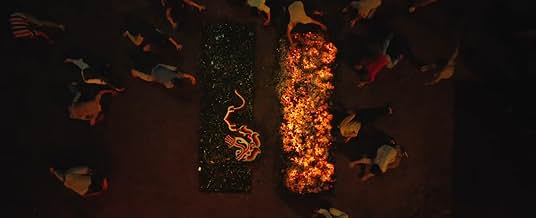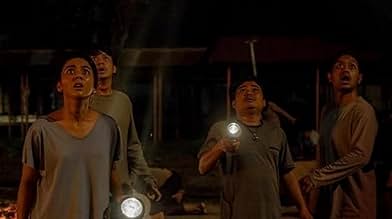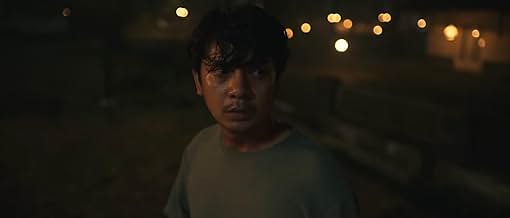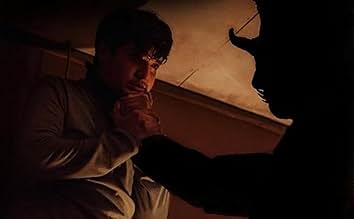IMDb रेटिंग
6.1/10
2.4 हज़ार
आपकी रेटिंग
अपनी भाषा में प्लॉट जोड़ेंA group of seasonal laborers who come to an old sugar factory in the countryside to work during the harvest season.A group of seasonal laborers who come to an old sugar factory in the countryside to work during the harvest season.A group of seasonal laborers who come to an old sugar factory in the countryside to work during the harvest season.
फ़ीचर्ड समीक्षाएं
10Yuki-08
Pabrik Gula successfully conveys deep social criticism without losing its cinematic aesthetics. Directed with great visual precision, the film depicts the lives of sugar factory workers with a heart-wrenching yet empathetic narrative. The images of old factories, creaking machines, and the harsh working atmosphere are shown not as documentation, but as symbols of an outdated and suffocating system.
One of the film's strengths lies in its ability to capture the stillness and facial expressions of its characters. There is not much dialog, but the expressions and atmosphere are enough to convey emotion and tension. The minimal background music reinforces the impression of silence and the heavy burden of life borne by the characters.
Pabrik Gula is a movie that gives the audience room to reflect. It does not lecture, but shows clearly-through the daily life behind the walls of an old factory-about inequality, injustice, and human resilience in the face of an unfavorable system.
One of the film's strengths lies in its ability to capture the stillness and facial expressions of its characters. There is not much dialog, but the expressions and atmosphere are enough to convey emotion and tension. The minimal background music reinforces the impression of silence and the heavy burden of life borne by the characters.
Pabrik Gula is a movie that gives the audience room to reflect. It does not lecture, but shows clearly-through the daily life behind the walls of an old factory-about inequality, injustice, and human resilience in the face of an unfavorable system.
10Mr-543
I can scared , laughed and cry angry with the same movie. 1st experience with horror like that and it was really good.
And its bring lot of indonesian culture so its excited when i see it in cinema.
The adult scene is just a minor to complete story but i dont care about it cause the story was so good.
And the jump scare was like bam bam bam never stop but and then i get into the story with laugh, curious about pabrik gula and suddenly there is mini jump scare with twist and bam bam bam wow i couldnt rest one bit but its true experience with rest and laugh after that and then ready again for another sequence WOW.
And its bring lot of indonesian culture so its excited when i see it in cinema.
The adult scene is just a minor to complete story but i dont care about it cause the story was so good.
And the jump scare was like bam bam bam never stop but and then i get into the story with laugh, curious about pabrik gula and suddenly there is mini jump scare with twist and bam bam bam wow i couldnt rest one bit but its true experience with rest and laugh after that and then ready again for another sequence WOW.
10RidoG-5
"Pabrik Gula" is strong evidence that local culture can be a source of horror that is no less creepy than the western stories we have seen so often. In this movie, myths and legends rooted in the traditions of the community around the factory become the main foundation of tension. The result is a horror movie that feels very authentic, nuanced, and certainly gripping in a very Indonesian way.
Right from the start, "Pabrik Gula" hints that this place is more than just an old, empty building. There is a deep-rooted dark history, told for generations by the locals. Stories about the spirits of the workers, bloody sacrifices, and supernatural creatures that are said to guard the factory become the backdrop that enriches the atmosphere of the movie. But the greatness of this movie is how all of that is conveyed subtly, unhurriedly, and without explaining everything explicitly. The audience is invited to feel, guess, and imagine for themselves the horrors that might be hidden behind the factory walls.
The use of local mythology does not feel forced. It flows naturally into the narrative, strengthening the characters' motivations and shaping a threat that feels much more real because it is based on beliefs that live in the community. In this way, the fear presented in "Pabrik Gula" becomes a collective fear - something we've all heard from our parents' stories, and because of that, it feels closer and more intimidating.
The acting of the cast really supports this authenticity. They managed to show a different kind of fear: not just fear of what they saw, but fear of something bigger, something that has lived in their culture for a long time. There is a hesitant expression, a deep respect for the supernatural, and sometimes a resigned attitude that shows they know how small humans are in the face of those unseen forces.
The cinematography of the movie reinforces this atmosphere. The camera often captures small elements - forgotten offerings, strange scribbles on the wall, the faint sound of gamelan in the distance - all of which enrich the world of "Sugar Factory" without having to explain it. It's a very clever form of visual storytelling: building a living, breathing world without having to make it feel contrived.
Music and sound design also play an important role in building the mythological atmosphere of the movie. Instead of relying on loud modern scoring, "Pabrik Gula" uses traditional instruments, gamelan sounds, and ancient chants layered with creepy sound effects. This provides an additional layer of authenticity and deepens the impression that what we are witnessing is not just a fictional story, but a reflection of real beliefs and fears.
The story in "Sugar Factory" develops slowly, like a slowly creeping fog. Every little clue about the factory's past, every secret uncovered, brings us closer to the core of the curse that surrounds this place. The movie doesn't offer easy answers; it respects the complexity of myth, where the line between reality and belief is often blurred. This makes for a much richer and evocative viewing experience.
One of the movie's greatest strengths is how it treats the theme of belief with respect. It doesn't mock superstition or treat local beliefs as ridiculous. Instead, it recognizes that myths have power, both in shaping communities and in shaping individual fears. This provides an additional emotional layer that we rarely see in modern horror films.
The ending of the movie is also very satisfying. Without giving too much away, one could say that "Sugar Factory" closes its story with a sense of mythological justice - that everything done in the past must be paid for, that there is a balance to be restored, even if it means going through terror and destruction. It's a bittersweet ending but feels very much in keeping with the feel that has been built up throughout the movie.
Overall, "Sugar Factory" is a horror masterpiece that manages to combine suspense, atmosphere, and the richness of the local culture in a very satisfying way. It is a movie that not only scares, but also invites the audience to reflect on our relationship with the past, with the land we stand on, and with the beliefs that shape who we are.
For anyone looking for a horror movie with depth of theme and a strong local flavor, "Pabrik Gula" is the perfect choice. It is proof that Indonesian horror has its own unique voice - a voice that is creepy, melodious, and truly haunting.
Right from the start, "Pabrik Gula" hints that this place is more than just an old, empty building. There is a deep-rooted dark history, told for generations by the locals. Stories about the spirits of the workers, bloody sacrifices, and supernatural creatures that are said to guard the factory become the backdrop that enriches the atmosphere of the movie. But the greatness of this movie is how all of that is conveyed subtly, unhurriedly, and without explaining everything explicitly. The audience is invited to feel, guess, and imagine for themselves the horrors that might be hidden behind the factory walls.
The use of local mythology does not feel forced. It flows naturally into the narrative, strengthening the characters' motivations and shaping a threat that feels much more real because it is based on beliefs that live in the community. In this way, the fear presented in "Pabrik Gula" becomes a collective fear - something we've all heard from our parents' stories, and because of that, it feels closer and more intimidating.
The acting of the cast really supports this authenticity. They managed to show a different kind of fear: not just fear of what they saw, but fear of something bigger, something that has lived in their culture for a long time. There is a hesitant expression, a deep respect for the supernatural, and sometimes a resigned attitude that shows they know how small humans are in the face of those unseen forces.
The cinematography of the movie reinforces this atmosphere. The camera often captures small elements - forgotten offerings, strange scribbles on the wall, the faint sound of gamelan in the distance - all of which enrich the world of "Sugar Factory" without having to explain it. It's a very clever form of visual storytelling: building a living, breathing world without having to make it feel contrived.
Music and sound design also play an important role in building the mythological atmosphere of the movie. Instead of relying on loud modern scoring, "Pabrik Gula" uses traditional instruments, gamelan sounds, and ancient chants layered with creepy sound effects. This provides an additional layer of authenticity and deepens the impression that what we are witnessing is not just a fictional story, but a reflection of real beliefs and fears.
The story in "Sugar Factory" develops slowly, like a slowly creeping fog. Every little clue about the factory's past, every secret uncovered, brings us closer to the core of the curse that surrounds this place. The movie doesn't offer easy answers; it respects the complexity of myth, where the line between reality and belief is often blurred. This makes for a much richer and evocative viewing experience.
One of the movie's greatest strengths is how it treats the theme of belief with respect. It doesn't mock superstition or treat local beliefs as ridiculous. Instead, it recognizes that myths have power, both in shaping communities and in shaping individual fears. This provides an additional emotional layer that we rarely see in modern horror films.
The ending of the movie is also very satisfying. Without giving too much away, one could say that "Sugar Factory" closes its story with a sense of mythological justice - that everything done in the past must be paid for, that there is a balance to be restored, even if it means going through terror and destruction. It's a bittersweet ending but feels very much in keeping with the feel that has been built up throughout the movie.
Overall, "Sugar Factory" is a horror masterpiece that manages to combine suspense, atmosphere, and the richness of the local culture in a very satisfying way. It is a movie that not only scares, but also invites the audience to reflect on our relationship with the past, with the land we stand on, and with the beliefs that shape who we are.
For anyone looking for a horror movie with depth of theme and a strong local flavor, "Pabrik Gula" is the perfect choice. It is proof that Indonesian horror has its own unique voice - a voice that is creepy, melodious, and truly haunting.
Some critics seem to be blindly judging this film without knowing the reasons and why it was made. It is clear that this film is based on true events,which happened in the sugar factory. And some people don't like the way the story goes. How can people change the true story? The main key to making this film is to retell what happened rather than changing the storyline to make it more interesting. To be honest, this film has very good quality, in terms of the storyline I don't care, because it's a true story. I like his jumpscare the most, very effective, even the ghost faces are scary, and a very good experienced. The audio visual is good.
For one liner: a good cinematography ruined by bad storyline. I don't know how the scriptwriters wrote the plot (maybe the production house was controlling the creative too much, or just simply they spent too much budget on the artistic points), but even for someone who is too coward to watch horror movies like me, I get annoyed by the storyline.
I did not expect that much before watching this movie, but the storyline seemed getting worse and worse until the end. But the cinematography was good. And the comedy brought by the stand-up comedians was natural and on-point.
Well, just go to the cheaper cinema, laugh a bit and enjoy the too-many jumpscares, to get a good value for your ticket.
I did not expect that much before watching this movie, but the storyline seemed getting worse and worse until the end. But the cinematography was good. And the comedy brought by the stand-up comedians was natural and on-point.
Well, just go to the cheaper cinema, laugh a bit and enjoy the too-many jumpscares, to get a good value for your ticket.
क्या आपको पता है
- ट्रिवियाThe teaser poster of this film receives backlash due to it's sensual nature.
- क्रेज़ी क्रेडिटMD Pictures logo features Red Light.
- साउंडट्रैकPesta Rakyat Pabrik Gula
Performed by LAIR
Written by Tedi Nurmanto
Courtesy of Guruguru Brain
टॉप पसंद
रेटिंग देने के लिए साइन-इन करें और वैयक्तिकृत सुझावों के लिए वॉचलिस्ट करें
विवरण
- चलने की अवधि2 घंटे 13 मिनट
- रंग
- ध्वनि मिश्रण
- पक्ष अनुपात
- 2.35 : 1
इस पेज में योगदान दें
किसी बदलाव का सुझाव दें या अनुपलब्ध कॉन्टेंट जोड़ें


![Trailer [OV] देखें](https://m.media-amazon.com/images/M/MV5BMmVmZGFlMzQtZmJkZS00YmMwLThiYzQtMjVjMDMyOTUyNGYwXkEyXkFqcGdeQXRyYW5zY29kZS13b3JrZmxvdw@@._V1_QL75_UX500_CR0)

















